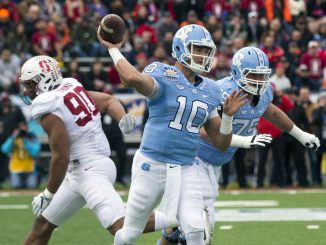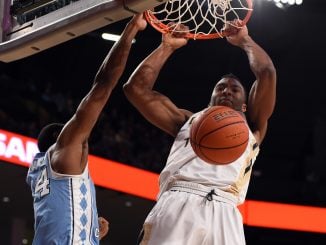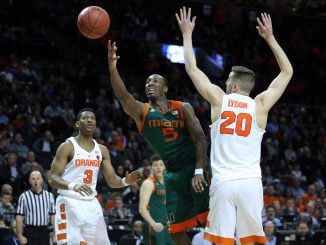Roman Gabriel was ahead of his time, glamorizing professional football in Los Angeles before the NFL was desperate to do so, evolving into one of the biggest names in the NFL during the late 1960s and early 1970s. The L.A. Rams starting quarterback played in the City of Angels during its purest and toughest era, a time when players didn’t just play for money, but for love of the game.Roman played in the league with a group of elite quarterbacks, including Johnny Unitas and Bart Starr, at time when the NFL sported some of the most feared tacklers in the history of the game. Week in and week out featured matchups against the likes of Dick Butkus, Ray Nitsckhe and Bob Lilly from the Doomsday Defense in Dallas. Roman took his lumps and hits, but proved he was tough as nails, starting 89 consecutive games for the Rams despite knee and shoulder injuries.He was a Cam Newton before Newton was born, the first large quarterback in NFL history at 6-foot-4, 235-lbs. He could slice up defenses with his pinpoint passes, heave the ball 70 yards and shake off tacklers unlike few others.”Nobody in the history of the game is as strong as Gabe,” said former Dallas Cowboys coach Tom Landry.Vince Lombardi once described Roman’s body as a “big telephone poll.” They say Roman once threw a ball 90 yards, almost the entire length of the football field, but it was ruled an incomplete pass. He won the NFL MVP and was voted First Team All-Pro in 1969, played in 4 Pro Bowls (1967, 1968, 1969, and 1973) and won NFL Comeback Player of the Year Award in 1973.When he retired, he ranked as the Rams all-time passing leader with 22,223 yards, 154 touchdowns and 1,705 passes completed.From 1967 to 1970, the Rams were one of the best teams in football, with a record of 41-11-4. Gabriel led the Rams to either a first or second-place division finish in that stretch. The Rams weren’t just known for their offense, though, as they had one of the greatest defensive lines in the Fearsome Foursome (Merlin Olson, Deacon Jones, Rosey Greer and Lamar Lundy). Butkus once called them “the most dominant line in football history.”During the 1967 and 1969 seasons, the Rams lost in the divisional round to the Green Bay Packers and Minnesota Vikings, both of whom went on to play in the Super Bowl. L.A.’s best season came in 1969, a first-place division finish highlighted by Gabriel’s MVP campaign.Somehow Gabriel became an overlooked figure in NFL historical lore: a former No. 2 pick (No. 1 in the AFL too) with an MVP award on his resume and a lengthy run of success in the NFL, Gabriel never garnered the votes necessary to enter the Pro Football Hall of Fame. No gold jacket, no induction speech. That needs to change.Roman, a Wilmington, N.C. native who attended New Hanover High, was a three-sport athlete who played football, baseball and basketball. He was voted the best amateur baseball player in the Carolinas and was offered a contract by the New York Yankees. He passed on the opportunity to star at NC State, where during his freshman year he was also a three-sport athlete. It was on the football field he became a superstar, tearing up the Wolfpack record books en route to becoming a two-time All-American and back-to-back ACC Player of the Yqear in 1960 and 1961.Gabriel set 22 NC State records, nine conference records, and was inducted into the College Football Hall of Fame in 1989. On January 20, 1962, Gabriel’s No. 18 jersey was officially retired and presented to him by then-Governor Terry Sanford.”Gabe had a terrific impact on the football team,” said Earle Edwards, NC State’s legendary head football coach at the time, in a 1987 interview. “He sent us in a new direction and much of it he had to do on his own because we didn’t have the kind of supporting cast he deserved. He started us in the new direction and others followed.”Gabriel was the No. 1 overall pick in the 1962 AFL Draft by the Oakland Raiders, but signed with the L.A. Rams after being selected with the No. 2 selection in the 1962 NFL DraftRoman got off to a slow start with the Rams after not seeing playing time for the first few seasons. But after a change in leadership, head coach George Allen made Roman his new field general. In his second season as the Rams starting quarterback in 1967, Roman led his team to 11 wins and was handed his first Pro Bowl berth.He put together great seasons — notably in 1969 when he led the league in passing touchdowns (24), was honored as an All-Pro and was named MVP — but Gabriel’s best performances were on the biggest stages. The most memorable one probably came on December 17, 1967 against Unitas and the Baltimore Colts. The Colts were 11-0-2 and the Rams were 10-1-2 with the winner moving on to the playoffs. Gabriel put on a clinic, passing 18-of-22 for 257 yards and three touchdowns. The Fearsome Foursome also chimed in, punishing Unitas in the pocket, sacking him a total of seven times. The Rams beat the Colts 34-10.”You would have thought Gabriel was Unitas,” Allen said. “He sure held his poise out there. Roman has greatly matured over the past two years.”Unfortunately, injuries took their toll on Gabriel later in this career a torn tendon in the elbow of his throwing arm caused his stats to suffer and the Rams brought in another QB in John Hadl from the San Diego Chargers after the 1972 season. Roman then demanded a trade and was eventually traded to the Philadelphia Eagles.In 1973, in typical Roman form with his back against the wall, he led the league with 3,219 yards and 23 touchdown passes winning the NFL Comeback Player of the Year Award and earn another trip to the Pro Bowl. His total yards and passing completion percentage (58.7) were the best of his pro career. While with the Eagles (1973-77), he threw for 7,221 total yards and recorded 45 touchdown passes.Roman ranks among the NFL’s all-time leaders with 29,444 yards passing. That is more yards passing than Hall of Famers Len Dawson, Terry Bradshaw, Ken Stabler, Joe Namath, George Blanda, Bobby Layne, Bob Griese, Bart Starr, Norm Van Brocklin, Otto Graham, Roger Staubach and Sammy Baugh.Roman also passed for 201 touchdown passes which is more than Hall of Famers’ Bobby Layne, Ken Stabler, Bob Griese, Sammy Baugh, Otto Graham, Norm Van Brocklin, Joe Namath, Troy Aikman, Roger Staubach and Sid Luckman. Gabriel also has a better Touchdown to Interception Ratio (1.34) than Hall of Famers’ Frank Tarkenton (1.28), Johnny Unitas (1.14) and Bart Starr (1.10).Gabe was not your typical pocket passer either, as he rushed for 1,304 yards and 30 touchdowns. That is only six fewer TDs than Michael Vick, five less than Randall Cunningham and one more than Donovan McNabb.The debate on Gabriel found its way into pop culture lexicon, with Peter and Bobby of “Brady Bunch” vigorously arguing on a Season 4 episode (1972-73) about who had the better passing average: Joe Namath or Gabriel? Roman had the better career passing completion average at 52.0 percent to Joe Willie’s 50.1 percent. In fact, Gabriel threw more touchdown passes (201-173) and passed for more yards (29,444-27,663) than Namath.The obvious differentiator is Super Bowl III, in which the Jets defeated the Colts 16-7 after Namath famously guaranteed victory prior to the game. Gabrial’s best chance at a Super Bowl came during his 1969 MVP campaign as the Rams started the season at 10-0 and win their second division title in three seasons. However, L.A. lost to the Minnesota Vikings in the first round of the playoffs.The Hall of Fame does not consider off-field work but it is worth noting that Gabriel always gave back; having raised over $10,000,000.00 in his lifetime for various types of charities such as multiple sclerosis, muscular dystrophy, leukemia, the blind, Special Olympics and Salvation Army.So why is Roman Gabriel, the first Asian-American ever to play quarterback in the NFL, not in the Hall of Fame?It could be the competition in the league at the time, as Roman and other were often overshadowed by other Hall of Fame quarterbacks like Unitas, Starr and Namath. The lack of a title does not help: all three of those quarterbacks won at least one Super Bowl. Some might say that Roman could never win the big game or that his playoff record was nothing to write home about? Could it be because the Rams might have lost some of their historical significance and tradition when having moved from Los Angeles to St Louis in 1995 and then back to Los Angeles in 2016?The style of the modern game does not help Gabriel either. Modern rules are catered towards quarterbacks, which has resulted in an explosion of passing statistics. Quarterbacks from the 60’s and 70’s are having their numbers dwarfed by average passers in the 2000’s. Dan Marino became the first quarterback to join the 5K club when he threw for 5,084 yards in 1984. Since then, there have been four different quarterbacks to topple the number, and they have done it eight times over the last eight seasons.Could these quarterbacks have survived in a more violent, hard-hitting and demolition style of play that Gabriel had played in? Could Drew Brees take a monstrous hit from former Blitzer Mike Curtis of the Colts that is pictured in the famous photograph of him tackling Roman’s head? Did Roman suffering eight concussions during his career and having withstood 13 surgeries including a collapsed lung in 1972 hinder him in any way?Gabriel played the game how it should have been played, hard and tough. He played hurt, he grinded out seasons, he did whatever it took to give his team a chance to win the game. Roman had a ton of success on the football field and the record books do most of the talking. He has better numbers than quite a few of the quarterbacks that are already in the Hall of Fame, no disrespect to those fine athletes. Time should not erode away his production, nor should the ease with which modern quarterbacks put up statistics cripple his chances at receiving what he and his family deserve, a gold jacket.A walk into Carter-Finley Stadium is impossible without seeing the homage to Gabriel and all he did in Raleigh as a collegiate star. His name is retired there, it’s on banners and it’s outside on a plague located at Earle Edwards Walk of Champions. Gabriel was inducted into the 2012 Inaugural NC State Athletics Hall of Fame.Gabriel was a big fish in the smaller pond of Raleigh and remained that way when he leapt to the large lake of the NFL. He deserves a similar honor, and should be the first Wolfpack alum inducted into Canton, at the larger level as well.
Related Articles

Sports
UNC stands to benefit if Trubisky picked No. 1
Although it’s not as certain as it seemed earlier in the day, there’s still a chance that North Carolina quarterback Mitch Trubisky will be the first player selected in the NFL draft tonight. The benefits […]

Sports
Georgia Tech stuns UNC in ACC hoop opener
ATLANTA — After freshman Josh Okogie scored only five points in a near loss to North Carolina A&T in Georgia Tech’s previous game, Yellow Jackets coach Josh Pastner had a heart-to-heart talk with Okogie. The […]

Sports
Miami poses difficult first ACC tourney test for UNC
BROOKLYN, N.Y. — North Carolina didn’t have the luxury of hand-picking its opponent in the first round of the ACC tournament. Miami and Syracuse played for that distinction on Tuesday. If the Tar Heels had […]
